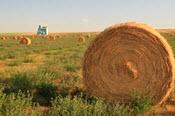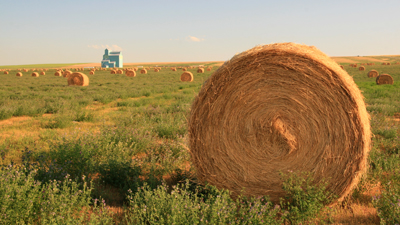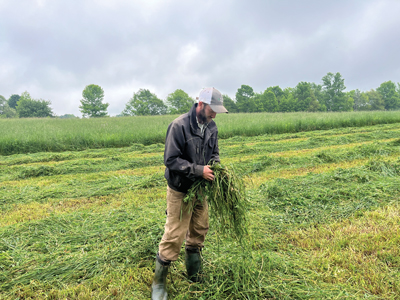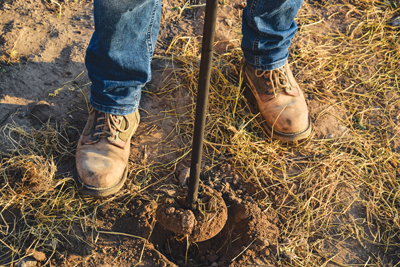
These top tips can help improve your stand.
By Patrick Lynch
I work with farmers and seed companies that sell forage seed across the country. The following questions come from farmers in the Prairies as well as Eastern Canada. Some questions are the same in every province. Others are very specific to certain areas.
Here is one of the best and most often asked questions.
Question: I sold seed to a farmer and he thinks there were weed seeds in it. What can I do?
Answer: This one is easy to answer. First, I ask the farmer how he seeded the alfalfa. Most common answer is a drill. I ask if the alfalfa is coming up in rows. The answer is yes. Then I ask if the weed is in the rows or between the rows. Typically, the answer is “I don’t know.” When they get back to me, they say that the weeds are in the row and between the rows. That means the weeds were in the soil and not in the forage seed.
If the alfalfa is planted broadcast, I ask if the weeds are uniform across the whole field or just in areas. The answer has always been “just in areas.” This points to the fact the weeds were in the soil, not in the forage seed.

Sometimes the farmer will tell me they have never seen this weed before on this farm. That is possible, if the farmer has a rotation where the various herbicides used are controlling the weed all the time. If it is a winter annual, and the field is worked before planting, that tillage will control the weed.
Question: Last year I saw a great response from putting sulphur on my alfalfa. This year I did not see as great a response. Why?
Answer: Forages need sulphur. There is sulphur in the soil, but it will not be released until the soil warms. In a cool spring, applied sulphur has a greater visual effect than in a spring when the soil warms up and releases soil sulphur. But even though you do not see the colour response when you apply sulphur, there still can be a yield response. Bottom line, all forages should get sulphur.
Supplementary Question: Can I add this sulphur in the fall?
Answer: I do not know. I cannot find any research that addresses this question for forages. Another good research project that could be looked at: Timing, rate, and source of sulphur on forages. There are some agronomists who believe adding sulphur in the fall is not only good, but the best way to do it. In the spring when sulphur is not available to plants, because of cold soils, it is often too wet to spring-apply sulphur. If you have fall-applied sulphur, it will be available in the spring.

Question: What if the stand does not catch?
Answer: There are a lot of questions to seed dealers about replacing forage seed because the stand did not catch due to dry soil conditions. Farmers would like to be reimbursed if the stand does not catch.
Since this question comes up so often, growers should ask their seed supplier about their company’s policy on replacing seed because the stand did not catch due to dry weather. Many seed companies have some type of policy for a certain percentage replacement.
Years ago, replacing seed because of dry weather was not an issue – it was just a fact of farming. Some years dry weather prevented establishment. I remember what one dealer said to his customer.
Farmer: “My seed didn’t catch; I want my money back.”
Dealer: “No problem – just bring the seed back and I will give you your money back.”
Not sure if that dealer is still in business.
Question: Any advice on fertilizer?
Answer: I get many questions on what is the best fertilizer for a forage field. My first question, in return, is: Do you have a soil test?
Invariably I get one of two responses. First response is “no.” Second response is “I do but it’s a bit old and I don’t know where the results are.”
This begs another question. Why are you not soil testing?
To be farming without soil tests is like having a bank account with no records of what you deposited or withdrew. Soil tests measure soil nutrients and soil pH. You may not be able to change the pH, but you can pick forage species that do better on soils with a certain pH. In modern agriculture, having a current soil test is as basic as checking the fuel in a tractor. Get it done.

When addressing the fertilizing of forages I ask, “did you apply manure?” Sometimes the answer is “yes.” Then I ask about the rate and analysis of the manure. This is too often answered with silence. Then I have to do a quick calculation on rate based on loads per acre and a guess as to the weight of each load. Then I use average numbers for manure value. Pretty crude for today’s agriculture. It is like spreading fertilizer when you have no idea of the rate or the analysis. You wouldn’t apply fertilizer without knowing the analysis, so why do you apply manure without knowing its value?
Question: I sprayed my barley and underseeded alfalfa with Pardner and a fungicide. The barley is all burnt and looks terrible.
Answer: Often you can decrease leaf burn by using more water. “You told me you used 20 gallons of water. However, this year we are seeing significant leaf burn with certain combinations of fungicides and herbicides. I am sure it will be OK.”
Two weeks later I checked back with the grower. He was quite pleased. After he sprayed, they received a good amount of rain and the barley was looking great.
Question: How come alfalfa weevil showed up in my second-cut alfalfa this year. You said that by taking first cut I would get rid of the weevils?
Answer: Alfalfa weevil is a significant pest in alfalfa in Eastern Canada. And it is moving to Western Canada. Blame it on global warming or the government or whatever. The reality is that it is coming. In Eastern Canada we used to be able to control it with cutting. Taking first cut early removed weevils.
There are several factors in play which led to the question above.
The “cut and they are gone” recommendation was valid during the last bad cycle of alfalfa weevil in Eastern Canada during the ’70s. During that period, we were taking first cut a few days later than we are now. But the main reason is because we are cutting higher now. We used to cut at 1-1/2 to two inches. Currently a three-inch cutting height is standard. This higher cutting height means there is more feed left for the surviving weevil and we are not physically removing as many weevil.
It is also possible that the weevil is evolving. Weevils that hatch later and are smaller when first cut is taken may be more prevalent. We kill the first-hatched ones and later hatches survive and continue to build.
Question: I planted alfalfa after a cereal crop and I thought I killed the volunteer cereal with tillage. Now I have volunteer cereal coming up in strips from behind the combine. Will this matter?
Answer: Volunteer cereal at a low level through the field will not hurt alfalfa. But if it is heavy – as in two to three times a normal seeding rate – this will crowd out the alfalfa. Even if the alfalfa survives through fall, the cereal will lodge with snow and kill the alfalfa. You must spray a herbicide like Assure or its generic to control volunteer cereal. If you can just spray the area behind the combine this can work. If you must spray the whole field, you will kill any grass forage that you planted. This means you will have to reseed the grass.
Question: When should I cut my forage triticale?
Answer: There are a lot of cereals grown for forage in the Eastern U.S. and Canada. One of the current most popular is triticale, which is a man-made cross between wheat and cereal rye. The first improved varieties were started at the University of Manitoba. The variety Rosner was released in 1969.
We do have some research to answer the question above. The answer is in the new Forage Publication 61 produced by the Ontario Ministry of Agriculture and Food.
It depends on what you want and whether when you can harvest. The bottom line is that protein will drop from 16 to 18 per cent at boot stage to 10 to 12 per cent at dough stage. But as the crop goes from boot to dough stage there is an increase in dry matter. As you go to boot stage you are not losing protein per acre but are lowering the percent protein.
This research was done in the ’90s. I feel that newer triticale varieties may show different results. The research was with a certain percentage of peas. We need research looking at various seeding rates of peas. Also, this is the feed value as it stands. How you harvest and store will affect your final feed quality.
These and other questions mean we need more answers to basic forage production issues. Not only to these questions, but to a lot of basic forage questions, such as “how much nitrogen credit do I get when I terminate alfalfa, or an alfalfa-grass mix or straight grass.” “Do fungicides pay on forages?”
We know that forages are valuable in building soil health and improving sustainability. But we know relatively little about forage production compared to our knowledge about other major field crops.
There is a general lack of basic forage production research across North America. Dr. Dan Undersander, a very famous forage researcher from Wisconsin, has not been replaced with a forage production researcher.
Maybe Rob Black, the Canadian senator who is leading the charge for soil health, can initiate some research to help with these questions. I know he knows the value of forages in building soil health.
In the meantime, those of us on the front line will be giving answers often based on experience, not research. BF



Post new comment